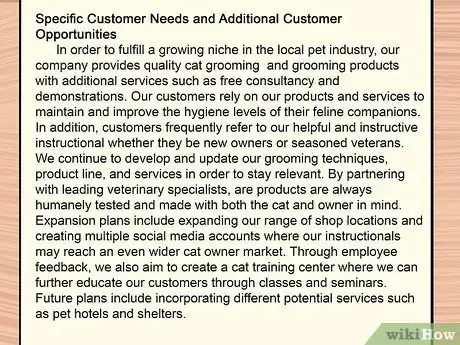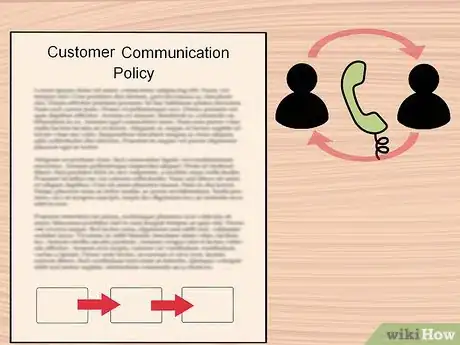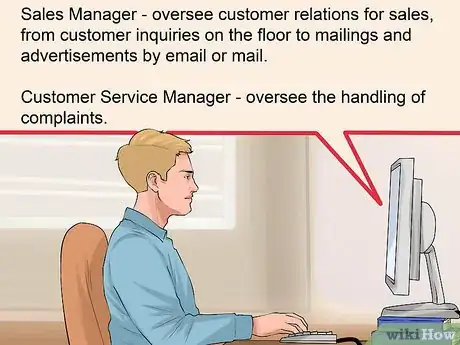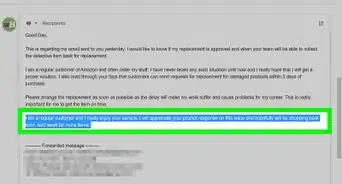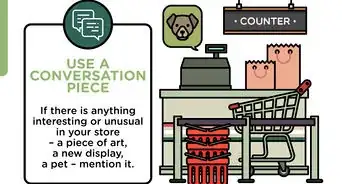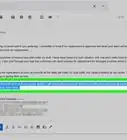This article was co-authored by Michael R. Lewis. Michael R. Lewis is a retired corporate executive, entrepreneur, and investment advisor in Texas. He has over 40 years of experience in business and finance, including as a Vice President for Blue Cross Blue Shield of Texas. He has a BBA in Industrial Management from the University of Texas at Austin.
This article has been viewed 84,369 times.
A customer relationship management (CRM) plan is a key component of running your business, as it describes how employees should deal with customers and provides a strategy for developing customer relationships. When writing a customer relationship management plan, it's important to define employee conduct and methods of handling customer inquiries or complaints in a manner that is easy to understand. The CRM plan also considers ways to foster a stronger, profitable relationship with a customer, not only dealing with him when problems or questions arise. Additionally, allowing room for improvements and adaptations as a result of periodic assessments will result in a more effective customer relationship management plan. The following steps will show you how to write a customer relationship management plan.
Steps
Reconciling Customer and Company Needs
-
1Confirm your company goals. A company's goals consist of what its management wants to achieve over the next period or a longer time frame. These can include driving repeat sales, increasing profits, increasing brand awareness, or building customer loyalty, among others. Try to set definitive, measurable goals, like increasing profits by 10 percent over the next two years. Identifying company goals will help you identify the company's ideal customer.
- For example, if your goal is to increase repeat sales, you will need to focus more heavily on contacting and working with previous customers.
-
2Identify customer goals. Customers have their own goals when shopping for a product to buy or a service to use. These goals typically relate to qualities present in products or services that would drive the customer to choose that product or service or their competitors. Customer goals can include low price, convenience, broad selection, ease of use, reliability, proximity, and preferred communication channel. Working to meet these goals can help you structure your CRM plan.
- Most of this information should be available in the marketing/sales plan if it has been developed.
Advertisement -
3Define the components of customer relationships. Customer interactions, and thus areas to build customer relationships, include sales, billing, collection, service, and promotion, among others. Identify each point of contact you will have with customers so that you can work it into your CRM plan. Remember that this is a customer relationship management plan, and thus is much broader than a simple customer service plan.
Gathering Information
-
1Examine how your company currently handles customer relations. Take a look at the methods you employ to maintain customer relations. For each department that communicates with customers, write down what they do and whether it represents the level of service you desire. Make sure to look at all outward-facing aspects of your business, including front-office employees (those in direct contact with customers face to face, on the phone, or online), back office employees (those who work with customers indirectly through marketing, billing, or financial operations), and business operators (those who represent the business at trade conferences and industry events).
- Typically, the departments that interact directly with customers need guidelines on how to conduct themselves to best represent your company, as well as how to effectively handle inquiries they cannot resolve themselves. Depending on the type of company, this can pertain to departments such as sales, customer service, or repairs.
- Additionally, many companies send out email updates and newsletters to communicate new developments to customers.
-
2Gather interaction information from customers. Figure out a way to gain customer interaction information from them. Your information gathering methods may be either direct or indirect. The former includes surveys, polls, and observations, while the latter consists of analyzing various records. For example, you can try using email surveys, providing them with a way to send in feedback, or simply talk to them as they come into the store (if possible).
- For indirect information gathering, look through your own records to figure out details like who your largest and profitable customers are, how often customers return after their first purchase, and which customers give you the most trouble (complaints, late payments, etc.).
- This information is easier to analyze if you have software for this purpose. CRM software packages may offer these tools.
- Identify your most valuable customers, which are usually customers purchasing profitable items or those who return often. Even though it may seem unfair, you need to incorporate in your plan a way to prioritize service to these customers.
- Use this information to identify the processes causing the most complaints. These could include missing prices, an inconvenient return policy, long checkout times, or late deliveries.
- You should also look for a way to cut off any customers that are more trouble than they're worth (excess complaints, unprofitable purchases, etc.).[1]
-
3Talk to your employees. Your employees, especially those who interact directly with customers, are an invaluable source of customer information. Call these employees in for meetings, or have their managers do the same, to get their feedback on various customer interaction points, your current CRM systems, and customer needs. Listen to any suggestions they may have and consider each one carefully.
- Ask employees for any requests they may have gotten from customers for additional services or products that the business does not currently offer. Ask them for any ideas they may have for additional offerings based on their experience with customers.[2]
-
4Investigate how your competition handles customer relations. Find out if they have a script to handle inquiries by phone, whether they send out email updates, and whether they utilize other forms of communication to stay in touch with their customers. Try to locate their customer satisfaction rating and set a higher goal for your own business.
- You can also work to triumph over your competitors by identifying another way to provide greater value to your customers. This can be in customer service, as described, or in things like unique product offerings or comprehensive service packages.[3]
- Describe your findings in writing so you can refer to them as necessary.
Writing Your CRM Plan
-
1Consider using a CRM plan template. There are resources online that can provide you with an outline from which you can build your own CRM plan. Doing so will help you make a complete and detailed plan. Try searching for "CRM plan template" on the search engine of your choice to find a good one.
-
2Summarize the information you gathered. Use the information that you found from your customers and employees to set new customer relationship goals. For example, you could be working to increase customer retention, improve customer service, and/or find new ways to meet your customers' needs. As you work through creating your CRM plan, plan out ways to achieve these goals. Then, break down each goal into small, measurable steps. The overall structure of your CRM plan should be large goals that are broken down into steps to take and an order to take them in.[4]
-
3Specify how the business meets or will meet customer needs. This section spells out exactly what products or services the business provides to its customers and how these offerings may be developed in the future. Describe your customers' needs in detail and how exactly your offerings help them remedy these needs. Include any areas that you've discovered through talking to your employees where customers have asked for additional products or services that you do not offer. In addition, brainstorm areas where you could offer to provide additional services or products without the customer asking for them.
- Evaluate your plans for additional offerings for risk and cost. Use this information to determine whether or not they are worth following.[5]
-
4Write a plan for customer retention. Customer retention spells out how you will earn repeat business from your customers by developing your relationships with them over time. Start by describing the current status of customer relationships in detail. How many first-time customers return for the same product or additional products? Specify ways that you could gain repeat business and how you can deepen relationships with existing regular customers. Work to identify any current obstacles to earning this sort of strengthened customer relationship. Then, brainstorm ways to overcome these obstacles.
- Clarify who will be responsible for developing these relationships in your plan (which department, employee(s), etc.).[6]
-
5Construct a policy to handle customer communications. One of the key aspects of your CRM plan will describe how your employees will interact with customers before, during, and after sales are made. These interactions should be directed to specific departments and relevant to their customer interactions. Describe this clearly in your plan, as it will be the keystone to improving customer relations for your company.
- Depending on your business, you should think of aspects such as the maximum amount of time a customer should have to wait, how long it will take to handle complaints, and who will be responsible for gathering customer feedback. To explain this process, you might create create flow charts that you can use to instruct employees.
- Examine which methods are conducive for customer relations. For example, many companies use both telephone and email for inquiries and complaints, while others employ surveys to improve customer service, and yet others utilize all forms of social media to keep customers abreast of company news.
- Implement customer feedback when creating a customer communications policy.
-
6Include financial and time budgets for your CRM plan. Set financial and time budgets for your customer relationship management plan and include them in a separate section. Oftentimes, companies not only train their employees in customer relations, but also create tools that facilitate communication such as separate customer service lines, website feedback forms and email, and social networking accounts. You'll need to allocate both money and time to develop tools to train employees and implement new methods of communication with customers.
-
7Determine who in the company will be responsible for each part of your CRM plan. For each type of contact, you should ideally appoint somebody from the appropriate department who instructs and oversees how employees handle communications with customers. For example, your sales manager can oversee customer relations for sales, from customer inquiries on the floor to mailings and advertisements by email or mail, while your customer service manager can oversee the handling of complaints. Specify clearly in your plan who will do what, and why they're being appointed for this task.
Improving Your CRM Plan
-
1Make sure the plan is implemented carefully. To be successful, a CRM plan will have to be implemented at all levels of the business organization. This will require a gradual change over from the previous way of handling customer relationships. Make sure that all of your employees are fully aware of the changes by holding workshops or meeting to instruct them on the new CRM policies well before they come into effect. Make sure all levels of management are aware of both their own responsibilities and the responsibilities of those below them. Be sure to emphasize the desired effect of the new CRM plan so that employees can be fully behind it.
-
2Describe how you will measure results. You'll need a way to identify how well your CRM plan is or isn't working after implementation. For example, this can involve surprise testing of your employees, as well as asking customers to participate in customer satisfaction surveys. Make sure that your results are measurable and not overly qualitative, so that you can get an objective picture of how well your plan is or isn't working.
-
3Share results with all customer-facing employees. Communicating the results to all teammates regularly, not just managers, will allow those doing the work to more easily identify problems and solutions. Explain to each department or group what they are doing well and what can be improved upon. They may also have improvement ideas of their own.
-
4Reward employees who stick to your CRM. Offer some positive reinforcement, such as a pay raise or a monthly lunch celebration, for employees who are working hard to implement the CRM. These kind of incentives will encourage other employees to do the same, in addition to raising morale.
-
5Evaluate your plan regularly. Take time every few months to identify what could be working better in your CRM strategy. Work with employees and customers after each change to assess how well it has worked and if it is actually providing its intended benefit. No plan is perfect, so make sure to leave room for making changes, especially in the beginning. Don't hold on to a bad strategy just because you were the one who created it.[7]
-
6Consider using CRM software. CRM technology can provide a business with the ability to store customer information, analyze customer strategies, and implement new CRM plans across the business quickly and easily. This is especially important for larger businesses that have difficulty maintaining information consistency across departments or locations. Be sure to develop your CRM strategy fully before deciding on a type of CRM software to use. Then, search online for software that can meet your needs.
- You may be able to get a full-service CRM package from one provider. However, you can also compile a CRM suite from different providers. Which you choose will depend on how much time and effort you want to spent on implementing the system.
References
- ↑ https://www.salesforce.com/crm/strategy/
- ↑ http://www.projectmanagementdocs.com/project-planning-templates/relationship-management-plan.html#axzz4CpKy6z8k
- ↑ http://www.projectmanagementdocs.com/project-planning-templates/relationship-management-plan.html#axzz4CpKy6z8k
- ↑ https://www.salesforce.com/crm/strategy/
- ↑ http://www.projectmanagementdocs.com/project-planning-templates/relationship-management-plan.html#axzz4CpKy6z8k
- ↑ http://www.projectmanagementdocs.com/project-planning-templates/relationship-management-plan.html#axzz4CpKy6z8k
- ↑ https://www.salesforce.com/crm/strategy/









